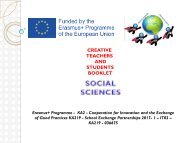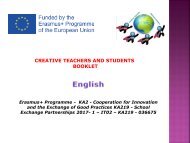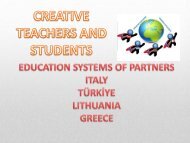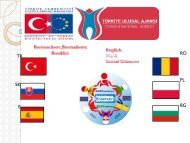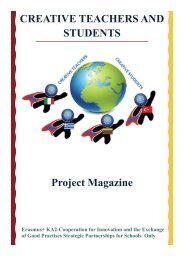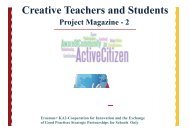besteachers,bestudents-social
Create successful ePaper yourself
Turn your PDF publications into a flip-book with our unique Google optimized e-Paper software.
TR<br />
RO<br />
SK<br />
PL<br />
E<br />
BG
Best methods of Social Sciences teaching<br />
There are many useful teaching methods to support effective teaching<br />
in <strong>social</strong> science to keep children motivated and fully occupied, but there<br />
is no single method of teaching which fits all the learning situations.<br />
Therefore, to make the learning of <strong>social</strong> science more enjoyable and<br />
effective, there is a need for innovations in teaching methods.
1 Lecture Method is the oldest procedure of teaching. It is widely used<br />
in schools and colleges. It is a good method its cover a wide topic at<br />
heights level of college or secondary schools and higher secondary<br />
classes but its success depends on the personality and ability of<br />
students.<br />
Why Thıs Method Should Be Used?<br />
1 To motivate students.<br />
2 To give an overview of a large topic.<br />
To add supplement the students reading.<br />
To make an importance matters understanding.<br />
To provide background of a topic or to introduce the topic<br />
To help the students to use their time wisely<br />
To explain the major concepts of a lesson<br />
To develop reasoning skill of students<br />
To have a classroom discussion
LECTURE METHOD
2-Dıscussıon Method: The word discussion means exchanging views and<br />
debate. Here the discussion can be among the group of students as a<br />
whole group.<br />
Where And When Can You Use Dıscussıon Method?<br />
1 the teacher of S.S. can use this method when he is using a project<br />
method.<br />
2 when he has to share information and ideas from a large group.<br />
3 when one needs to solve a problem, or do thinking and analytical<br />
activity in the class.<br />
4 when one obtain information and ideas from a large group of students.<br />
5 when one needs to check or evaluate students’ progress.<br />
Forms Of Dıscussıon: Formal, debate, classroom, informal, panel,<br />
symposium.<br />
The Process Of Dıscussıon:<br />
The process can be different depending upon the type of discussion.<br />
1 the ideas are initiated by the teacher than there is exchange of ideas<br />
opinions observations comments etc<br />
2 this is a co-operative learning.
DISCUSSION METHOD
3-EXCURSION METHOD<br />
The word ‘excursion’ means a journey, trip, tour planned for <strong>social</strong><br />
studies students in which the students actually visit places or site and<br />
has the first hand experience which excursion results in easy,<br />
interesting and effective learning.<br />
It provides ample opportunities to student for ‘seeing’ ‘hearing’<br />
examining, gathering data, and asking questions, such excursion are most<br />
conducive to learning.<br />
Prosses Of Orgenısıng Excursıon<br />
1. Decides the get information and details of the site you plan to visit<br />
and think of objective for organizing this trip.<br />
2. Take principal’s permission, take parents’ permission and get an ok<br />
from the place you are going to visit<br />
3. Orient the student about the trip, give them the details, give them a<br />
list of the thing you need to bring<br />
4. Conduct the trip take chaperone with you. Guide the students at the<br />
place. Then ask the student to write a report about their report.
3-EXCURSION METHOD
4-ROLE PLAY AND DRAMATIZATION METHOD:<br />
Role playing, socio drama or creative dramas are used to present a<br />
specific situation for study and discussion. There is no prepared script.<br />
It is unrehearsed, speaking parts are not memorized and minimum<br />
properties are used.<br />
Role play is a way of bringing situation from real life into the classroom.<br />
A role in other words, they pretend to be different person.<br />
A situation they pretend to be doing something different both a role $ a<br />
situation.<br />
In role play, students improvise the situation is fixed but they make up<br />
the exact as they go.<br />
Role Plays Are Use To Teach<br />
to clarify <strong>social</strong> values.<br />
to focus attention on a specific central ideas.<br />
to extend vocabulary.<br />
to gain grater insight into the problems of others.<br />
It develops <strong>social</strong> skills, communication skills and team spirit.<br />
They provide excellent basis for discussion and evaluation.
ROLE PLAY AND DRAMATIZATION METHOD
5-PROJECT METHOD:<br />
Steps Of Project Method:<br />
Project method is a direct outcome of pragmatism, especially of John<br />
Dewey’s educational philosophy. Pragmatism believes in reality. It is<br />
scientific and empirical. It is based on the principle of learning by doing.<br />
Being influenced by John Dewey, Kilpatrick tried to give project method<br />
in 1918. This method is democratic in nature and it emphasizes <strong>social</strong><br />
skills and team work.<br />
What Is A Project Method?<br />
It is a progressive approach of teaching. It is a purposeful act it<br />
provides the learner with learning experiences.<br />
Here the teacher acts like a guide assigns the projects to groups of<br />
students.’<br />
Each group works on different topics or problems. They work together<br />
to prepare the project.<br />
The students work together as a team, they learn by discussing, reading,<br />
and exchanging ideas. Then they take the help of a teacher wherever<br />
they difficulties or have questions.<br />
The project method covers the content of many different subjects and<br />
the teacher tries to integrate the information to the main topic.<br />
This method gives complete freedom and choice to students.
PROJECT METHOD
6-SOURCE METHOD:<br />
There are three types of sources in this method.<br />
1 Material resource: Ideas, machines, weapons etc…..<br />
2 Oral resources: Songs, folk stories, traditions, customs etc...<br />
3 Written and printed resources: Records, reports, letters etc….<br />
Source method is an activity oriented method. It is generally used in<br />
<strong>social</strong> studies subject also.<br />
Generally sources mean a person, books or document or picture or actual<br />
objects that can provide information for learning. It is learning directly<br />
from the actual sources for examples for <strong>social</strong> studies they can be- A<br />
contract with the bank – or studying the sample of stone collected from<br />
the moon or an object found from any ancient place can also be studied.<br />
One can also take students to museums to find the objects to study.<br />
Steps Followed To Use Source Method:<br />
1 Demonstration or presentation by the teacher.<br />
2 Locate related reading material and assign reading to the study.<br />
3 Problem solving by students; with group discussion among the students.
SOURCE METHOD
7-USE OF CURRENT EVENTS IN SOCIAL STUDIES:<br />
It is very important to have a quality current event programme in school.<br />
There are many things happening around the world. In addition to that<br />
issues and events which the student need to understand especially in the<br />
world around them.<br />
There are three approaches to teach current events.<br />
1 A separate subject approach.<br />
2 current events only based on the curriculum taught at school.<br />
3 separate units selected by the teacher.<br />
8-ACTIVITY BASED LEARNING<br />
This method is based on doing some hands-on experiments and activities.<br />
The students become active learners rather than passive recipients of<br />
information. The children are provided the opportunity to explore by<br />
their own so that the learning becomes joyful and long-lasting.
ACTIVITY BASED LEARNING
9-LOCAL CRAFT AND MUSEUM<br />
By visits to museums, students may explore the local surroundings and<br />
observe the activities of artisan communities engaged in different<br />
crafts using local skills and materials. The visits provide them<br />
opportunities and common platform to interact, experiment, create and<br />
perform according to their age, aptitude and ability and offer a barrierfree<br />
environment with immense possibilities of innovation.<br />
10-DRAMATISATION METHOD<br />
This is one of the most effective methods of stimulating the students in<br />
what they learn. It is a natural way by which students express freely<br />
their understanding of the life around them. The method allows for a<br />
great deal of involvement and participation by the students physically,<br />
emotionally and mentally. The students who are less active in academic<br />
work can also be engaged in this activity. This will provide them the<br />
opportunity to create a sense of belonging.
LOCAL CRAFT AND MUSEUM
11-COMPUTER AIDED LEARNING (CAL)<br />
In this method specially designed software applications are used to learn<br />
a subject . This creates an environment, where learning and assessment<br />
is fun and the opportunities to learn is equitable among the rural and<br />
urban children. The main objective of this programme is to attract the<br />
children, retain them in the schools and to improve the quality of the<br />
education through animated multimedia based educational content.<br />
12-SOCIAL SCIENCE LAB<br />
Well equipped Social Science Lab not only helps in creating and<br />
maintaining a much needed congenial atmosphere for effective learning,<br />
it provides a work room for the students- teachers because activities<br />
and the practical solution of problem characterize every unit or topic.<br />
The permanent display of important maps and globes, pictures and charts<br />
and constant reference to them by teaching is sure to make the teaching<br />
of <strong>social</strong> studies effective, lively and interesting.
13-LIBRARY<br />
Effective teaching of <strong>social</strong> science is crucially linked to the efficient<br />
functioning of the school library and of teachers who are trained to use<br />
the resources that the library provides. It is the major resource centre<br />
for learning activity. The library is therefore; set aside to meet the<br />
appetite for learning and to feed the hunger for understanding.<br />
Students can be assigned to read some items in the library to broaden<br />
their understanding of what the teacher has taught in the classroom
Isparta Gazi Social Sciences High School TÜRKİYE<br />
Profılırana Gımnazıa Hrısto Botev<br />
BULGARIA<br />
Zespol Szkol Ogolnoksztalcacych nr 3 w Katowicach POLAND<br />
Lıceul Teoretıc Mırcea Elıade<br />
ROMANIA<br />
Stredna Odborna Skola Polnohospodarstva A Sluzieb Na<br />
Vidieku SLOVAKIA<br />
Centre Educatıu Balaguer<br />
SPAIN



